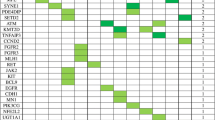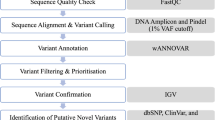Abstract
The role of next-generation sequencing (NGS) in identifying mutations in the driver, epigenetic regulator, RNA splicing, and signaling pathway genes in myeloproliferative neoplasms (MPNs) has contributed substantially to our understanding of the disease pathogenesis as well as disease evolution. NGS aids in determining the clonal nature of the disease in a subset of these disorders where mutations in the driver genes are not detected. There is a paucity of real-world data on the utility of this test in the characterization of triple-negative myeloproliferative neoplasms (TN-MPN). In this study, 46 samples of TN-MPN (essential thrombocythemia (ET) = 17; primary myelofibrosis (PMF) = 23; & myeloproliferative neoplasm unclassified (MPN-u) = 6) were screened for markers of clonality using targeted NGS. Among these, 25 (54.3%) patients had mutations that would help determine the clonal nature of the disease. Eight of the 17 TN-ET (47%) and 13 of the 23 TN-PMF (56.5%) patients had noncanonical mutations in the driver genes and mutations in the genes involved in epigenetic regulation. Identification of mutations categorized as high molecular markers (HMR) in 2 patients helped classify them as PMF with high risk according to the MIPSS 70 scoring system. A novel mutation in the MPIG6B (C6orf25) gene associated with childhood myelofibrosis was detected in a 14-year-old girl. The presence of clonal hematopoiesis could be confirmed in four of the six MPN-u patients in this cohort. This study demonstrates the utility of NGS in improving the characterization of TN-MPN by establishing clonality and detecting noncanonical mutations in driver genes, thereby aiding in clinical decision-making.





Similar content being viewed by others
Data availability
All data relevant to the study are included in the article or uploaded as a supplementary file. Additional clinical and genetic data, if required, are available on reasonable request.
References
Tefferi A, Lasho TL, Finke CM, Knudson RA, Ketterling R, Hanson CH et al (2014) CALR vs JAK2 vs MPL -mutated or triple-negative myelofibrosis: clinical, cytogenetic and molecular comparisons. Leukemia 28(7):1472–1477
Langabeer SE (2016) Chasing down the triple-negative myeloproliferative neoplasms: implications for molecular diagnostics. JAK-STAT 5(2–4):e1248011
Milosevic Feenstra JD, Nivarthi H, Gisslinger H, Leroy E, Rumi E, Chachoua I et al (2016) Whole-exome sequencing identifies novel MPL and JAK2 mutations in triple-negative myeloproliferative neoplasms. Blood 127(3):325–332
Diaconnu C, Mambet C, Necula L, Gurban P, Matei L, Aldea-Pitica I et al (2017) Triple negative myeloproliferative neoplasms - sometimes driver mutations stay low-key in plain sight. Roman Biotechnol Lett 23(4). https://doi.org/10.26327/RBL2017.12
McClure RF, Ewalt MD, Crow J, Temple-Smolkin RL, Pullambhatla M, Sargent R et al (2018) Clinical significance of DNA variants in chronic myeloid neoplasms: a report of the association for molecular pathology. J Mol Diagn 20(6):717–737
Alduaij W, McNamara CJ, Schuh A et al (2018) Clinical utility of next-generation sequencing in the management of myeloproliferative neoplasms: a single-center experience. Hemasphere. 2(3):e44. https://doi.org/10.1097/HS9.0000000000000044. (Published 2018 May 4)
Lee J, Godfrey AL, Nangalia J (2020) Genomic heterogeneity in myeloproliferative neoplasms and applications to clinical practice. Blood Rev 42:100708
Cabagnols X, Favale F, Pasquier F, Messaoudi K, Defour JP, Ianotto JC et al (2016) Presence of atypical thrombopoietin receptor (MPL) mutations in triple-negative essential thrombocythemia patients. Blood 127(3):333–342
Tefferi A, Lasho TL, Finke CM, Elala Y, Hanson CA, Ketterling RP et al (2016) Targeted deep sequencing in primary myelofibrosis. Blood Adv 1(2):105–111
NCCN Clinical Practice Guidelines in Oncology (NCCN Guidelines®) Myeloproliferative Neoplasms [Internet]. NCCN. 2022 [cited 16 June 2022]. Available from: https://www.nccn.org/professionals/physician_gls/pdf/mpn.pdf
Barbui T, Tefferi A, Vannucchi AM, Passamonti F, Silver RT, Hoffman R et al (2018) Philadelphia chromosome-negative classical myeloproliferative neoplasms: revised management recommendations from European LeukemiaNet. Leukemia 32(5):1057–1069
M. Maddali, U.P. Kulkarni, N. Ravindra, et al., Mutation profile in BCR-ABL1-negative myeloproliferative neoplasms: a single-center experience from India. Hematol Oncol Stem Cell Ther. https://doi.org/10.1016/j.hemonc.2021.03.002
Freed D, Aldana R, Weber JA, Edwards JS. The Sentieon Genomics Tools - A fast and accurate solution to variant calling from next-generation sequence data [Internet]. Bioinformatics; 2017 Mar [cited 2021 Nov 24]. Available from: http://biorxiv.org/lookup/doi/https://doi.org/10.1101/115717
Cunningham F, Achuthan P, Akanni W, Allen J, Amode MR, Armean IM et al (2019) Ensembl 2019. Nucleic Acids Res 47(D1):D745–D751
Zerbino DR, Achuthan P, Akanni W, Amode MR, Barrell D, Bhai J et al (2018) Ensembl 2018. Nucleic Acids Res 46(D1):D754–D761
Plagnol V, Curtis J, Epstein M, Mok KY, Stebbings E, Grigoriadou S et al (2012) A robust model for read count data in exome sequencing experiments and implications for copy number variant calling. Bioinformatics 28(21):2747–2754
Landrum MJ, Lee JM, Benson M, Brown G, Chao C, Chitipiralla S et al (2016) ClinVar: public archive of interpretations of clinically relevant variants. Nucleic Acids Res 44(D1):D862–D868
Hamosh A, Scott AF, Amberger JS, Bocchini CA, McKusick VA (2005) Online Mendelian Inheritance in Man (OMIM), a knowledgebase of human genes and genetic disorders. Nucleic Acids Res. 33(suppl_1):D514-7
Buniello A, MacArthur JAL, Cerezo M, Harris LW, Hayhurst J, Malangone C et al (2019) The NHGRI-EBI GWAS Catalog of published genome-wide association studies, targeted arrays and summary statistics 2019. Nucleic Acids Res 47(D1):D1005–D1012
Welter D, MacArthur J, Morales J, Burdett T, Hall P, Junkins H et al (2014) The NHGRI GWAS Catalog, a curated resource of SNP-trait associations. Nucleic Acids Res 42(D1):D1001–D1006
Stenson PD, Ball EV, Mort M, Phillips AD, Shiel JA, Thomas NST et al (2003) Human Gene Mutation Database (HGMD®): 2003 update. Hum Mutat 21(6):577–581
Mottaz A, David FPA, Veuthey A-L, Yip YL (2010) Easy retrieval of single amino-acid polymorphisms and phenotype information using SwissVar. Bioinformatics 26(6):851–852
Auton A, Abecasis GR, Altshuler DM, Durbin RM, Abecasis GR, Bentley DR et al (2015) A global reference for human genetic variation. Nature 526(7571):68–74
Lek M, Karczewski KJ, Minikel EV, Samocha KE, Banks E, Fennell T et al (2016) analysis of protein-coding genetic variation in 60,706 humans. Nature 536(7616):285–291
Sherry ST, Ward MH, Kholodov M, Baker J, Phan L, Smigielski EM et al (2001) dbSNP: the NCBI database of genetic variation. Nucleic Acids Res 29(1):308–311
gnomAD [Internet]. [cited 2022 Feb 24]. Available from: https://gnomad.broadinstitute.org/
Sim NL, Kumar P, Hu J, Henikoff S, Schneider G, Ng PC (2012) SIFT web server: predicting effects of amino acid substitutions on proteins. Nucleic Acids Res. 40(Web Server Issue):W452-7. https://doi.org/10.1093/nar/gks539
Adzhubei I, Jordan DM, Sunyaev SR (2013) Predicting functional effect of human missense mutations using PolyPhen-2. Curr Protoc Hum Genet Chapter 7:Unit7.20. https://doi.org/10.1002/0471142905.hg0720s76.
Schwarz JM, Cooper DN, Schuelke M, Seelow D (2014) MutationTaster2: mutation prediction for the deep-sequencing age. Nat Methods 11(4):361–362
Chun S, Fay JC (2009) Identification of deleterious mutations within three human genomes. Genome Res 19(9):1553–1561
Cosmic. COSMIC - catalogue of somatic mutations in cancer [Internet]. [cited 2022 Feb 24]. Available from: https://cancer.sanger.ac.uk/cosmic
Integrative Genomics Viewer - PMC [Internet]. [cited 2022 Feb 24]. Available from: https://www.ncbi.nlm.nih.gov/labs/pmc/articles/PMC3346182/
Kopanos C, Tsiolkas V, Kouris A, Chapple CE, Albarca Aguilera M, Meyer R et al (2019) VarSome: the human genomic variant search engine. Bioinformatics 35(11):1978–1980
Passamonti F, Thiele J, Girodon F, Rumi E, Carobbio A, Gisslinger H et al (2012) A prognostic model to predict survival in 867 World Health Organization–defined essential thrombocythemia at diagnosis: a study by the International Working Group on Myelofibrosis Research and Treatment. Blood 120(6):1197–1201
Passamonti F, Cervantes F, Vannucchi AM, Morra E, Rumi E, Pereira A et al (2010) A dynamic prognostic model to predict survival in primary myelofibrosis: a study by the IWG-MRT (International Working Group for Myeloproliferative Neoplasms Research and Treatment). Blood 115(9):1703–1708
Richards S, Aziz N, Bale S, Bick D, Das S, Gastier-Foster J et al (2015) Standards and guidelines for the interpretation of sequence variants: a Joint Consensus Recommendation of the American College of Medical Genetics and Genomics and the Association for Molecular Pathology. Genet Med Off J Am Coll Med Genet 17(5):405–424
Michail O, McCallion P, McGimpsey J et al (2021) Mutational profiling in suspected triple-negative essential thrombocythaemia using targeted next-generation sequencing in a real-world cohort. J Clin Pathol 74:808–811
Acha P, Xandri M, Fuster-Tormo F, Palomo L, Xicoy B, Cabezón M et al (2019) Diagnostic and prognostic contribution of targeted NGS in patients with triple-negative myeloproliferative neoplasms. Am J Hematol 94(10):E264–E267
Angona A, Fernández-Rodríguez C, Alvarez-Larrán A, Camacho L, Longarón R, Torres E et al (2016) Molecular characterisation of triple negative essential thrombocythaemia patients by platelet analysis and targeted sequencing. Blood Cancer J 6(8):e463–e463
Alvarez-Larrán A, López-Guerra M, Rozman M, Correa J-G, Hernández-Boluda JC, Tormo M et al (2019) Genomic characterization in triple-negative primary myelofibrosis and other myeloid neoplasms with bone marrow fibrosis. Ann Hematol 98(10):2319–2328
Luque Paz D, Riou J, Verger E, Cassinat B, Chauveau A, Ianotto J-C et al (2021) Genomic analysis of primary and secondary myelofibrosis redefines the prognostic impact of ASXL1 mutations: a FIM study. Blood Adv 5(5):1442–1451
Batis H, Almugairi A, Almugren O, Aljabry M, Alqahtani F, Elbashir E et al (2021) Detrimental variants in MPIG6B in two children with myelofibrosis: does immune dysregulation contribute to myelofibrosis? Pediatr Blood Cancer 68(8):e29062
Acknowledgements
We acknowledge Dr. Shaji Ramachandran Velayudan, CMC Vellore, and Dr. Vivek Gopalan and Medgenome laboratories for their help with the bioinformatic analysis of the data. Technical assistance provided by Ms. Hemamalini Suresh and Ms. Bhuvaneswari is greatly appreciated.
Funding
This study was funded by internal research grants from CMC, Vellore (IRB: 12942 & 11800) and Wellcome DBT India Alliance research grant (IA/CPHS/18/1/503930). P. B. and U. K. are supported by the Wellcome DBT India Alliance (IA/S/15/1/501842) and (IA/CPHE/17/1/503351), respectively. A. V. is supported by the Department of Biotechnology Junior research fellowship (DBT/2018/CMC/1138).
Author information
Authors and Affiliations
Contributions
All authors contributed to the study conception and design. Material preparation, data collection, and analysis were performed by Madhavi Maddali, Arvind Venkatraman, and Uday Prakash Kulkarni. The first draft of the manuscript was written by Madhavi Maddali and all authors commented on previous versions of the manuscript. All authors read and approved the final manuscript.
Conceptualization: M. M., V. M., P. B.
Methodology: M. M., A. V., S. M.
Formal analysis and investigation: M. M., A. V., U. K., S. M.
Writing—original draft preparation: M. M., U. K., P. B.
Writing—review and editing: A. K., F. N. A., S. L., S. S., A. A., B. G., V. M.
Funding acquisition: M. M., V. M.
Resources: B. G., E. S., M. T. M., S. R., A. A., S. L., S. S., U. K., V. M.
Supervision: P. B.
Corresponding author
Ethics declarations
Ethics statements
The present study is a retrospective analysis using DNA extracted from EDTA blood samples collected for routine molecular diagnostics in our institution from patients suspected of myeloproliferative neoplasms. No additional personal or clinical details were collected from any patient for this study. All procedures performed in this study involving human participants were as per the ethical standards of the institutional research committee. The research and the laboratory tests have been conducted following the World Medical Association Code of Ethics (Declaration of Helsinki, 1964).
Patient consent for publication
Not applicable.
Competing interests
The authors declare no competing interests.
Additional information
Publisher's note
Springer Nature remains neutral with regard to jurisdictional claims in published maps and institutional affiliations.
Supplementary Information
Below is the link to the electronic supplementary material.
Rights and permissions
About this article
Cite this article
Maddali, M., Venkatraman, A., Kulkarni, U.P. et al. Molecular characterization of triple-negative myeloproliferative neoplasms by next-generation sequencing. Ann Hematol 101, 1987–2000 (2022). https://doi.org/10.1007/s00277-022-04920-w
Received:
Accepted:
Published:
Issue Date:
DOI: https://doi.org/10.1007/s00277-022-04920-w




